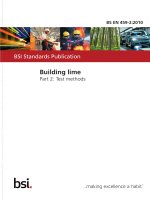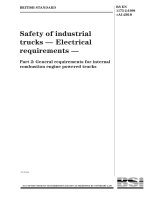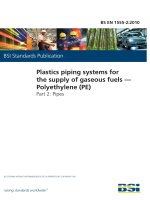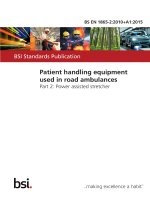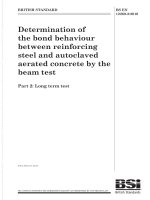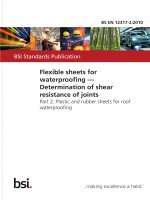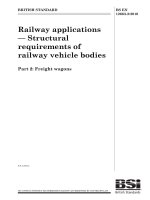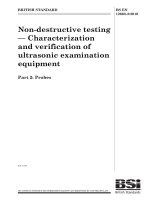Bsi bs en 61508 2 2010
Bạn đang xem bản rút gọn của tài liệu. Xem và tải ngay bản đầy đủ của tài liệu tại đây (788.88 KB, 94 trang )
BS EN 61508-2:2010
BSI Standards Publication
Functional safety of electrical/
electronic/programmable
electronic safety-related
systems
Part 2: Requirements for electrical/electronic/
programmable electronic safety-related systems
NO COPYING WITHOUT BSI PERMISSION EXCEPT AS PERMITTED BY COPYRIGHT LAW
raising standards worldwide™
BRITISH STANDARD
Licensed Copy: Science & Technology Facilities Council, 25/08/2010 10:13, Uncontrolled Copy, (c) BSI
BS EN 61508-2:2010
National foreword
This British Standard is the UK implementation of EN 61508-2:2010. It is
identical to IEC 61508-2:2010. It supersedes BS EN 61508-2:2002 which is
withdrawn.
The UK participation in its preparation was entrusted by Technical Committee
GEL/65, Measurement and control, to Subcommittee GEL/65/1, System
considerations.
A list of organizations represented on this committee can be obtained on
request to its secretary.
This publication does not purport to include all the necessary provisions of a
contract. Users are responsible for its correct application.
© BSI 2010
ISBN 978 0 580 56234 1
ICS 13.260; 25.040.40; 29.020
Compliance with a British Standard cannot confer immunity from
legal obligations.
This British Standard was published under the authority of the Standards
Policy and Strategy Committee on 30 June 2010.
Amendments issued since publication
Amd. No.
Date
Text affected
Licensed Copy: Science & Technology Facilities Council, 25/08/2010 10:13, Uncontrolled Copy, (c) BSI
BS EN 61508-2:2010
EUROPEAN STANDARD
EN 61508-2
NORME EUROPÉENNE
May 2010
EUROPÄISCHE NORM
ICS 25.040.40
Supersedes EN 61508-2:2001
English version
Functional safety of electrical/electronic/programmable electronic
safety-related systems Part 2: Requirements for electrical/electronic/programmable electronic
safety-related systems
(IEC 61508-2:2010)
Sécurité fonctionnelle des systèmes
électriques/électroniques/électroniques
programmables relatifs à la sécurité Partie 2: Exigences pour les systèmes
électriques/électroniques/électroniques
programmables relatifs à la sécurité
(CEI 61508-2:2010)
Funktionale Sicherheit sicherheitsbezogener
elektrischer/elektronischer/programmierbarer
elektronischer Systeme Teil 2: Anforderungen
an sicherheitsbezogene
elektrische/elektronische/programmierbare
elektronische Systeme
(IEC 61508-2:2010)
This European Standard was approved by CENELEC on 2010-05-01. CENELEC members are bound to comply
with the CEN/CENELEC Internal Regulations which stipulate the conditions for giving this European Standard
the status of a national standard without any alteration.
Up-to-date lists and bibliographical references concerning such national standards may be obtained on
application to the Central Secretariat or to any CENELEC member.
This European Standard exists in three official versions (English, French, German). A version in any other
language made by translation under the responsibility of a CENELEC member into its own language and notified
to the Central Secretariat has the same status as the official versions.
CENELEC members are the national electrotechnical committees of Austria, Belgium, Bulgaria, Croatia, Cyprus,
the Czech Republic, Denmark, Estonia, Finland, France, Germany, Greece, Hungary, Iceland, Ireland, Italy,
Latvia, Lithuania, Luxembourg, Malta, the Netherlands, Norway, Poland, Portugal, Romania, Slovakia, Slovenia,
Spain, Sweden, Switzerland and the United Kingdom.
CENELEC
European Committee for Electrotechnical Standardization
Comité Européen de Normalisation Electrotechnique
Europäisches Komitee für Elektrotechnische Normung
Management Centre: Avenue Marnix 17, B - 1000 Brussels
© 2010 CENELEC -
All rights of exploitation in any form and by any means reserved worldwide for CENELEC members.
Ref. No. EN 61508-2:2010 E
Licensed Copy: Science & Technology Facilities Council, 25/08/2010 10:13, Uncontrolled Copy, (c) BSI
BS EN 61508-2:2010
EN 61508-2:2010
-2-
Foreword
The text of document 65A/549/FDIS, future edition 2 of IEC 61508-2, prepared by SC 65A, System
aspects, of IEC TC 65, Industrial-process measurement, control and automation, was submitted to the
IEC-CENELEC parallel vote and was approved by CENELEC as EN 61508-2 on 2010-05-01.
This European Standard supersedes EN 61508-2:2001.
It has the status of a basic safety publication according to IEC Guide 104.
Attention is drawn to the possibility that some of the elements of this document may be the subject of
patent rights. CEN and CENELEC shall not be held responsible for identifying any or all such patent
rights.
The following dates were fixed:
– latest date by which the EN has to be implemented
at national level by publication of an identical
national standard or by endorsement
(dop)
2011-02-01
– latest date by which the national standards conflicting
with the EN have to be withdrawn
(dow)
2013-05-01
Annex ZA has been added by CENELEC.
__________
Endorsement notice
The text of the International Standard IEC 61508-2:2010 was approved by CENELEC as a European
Standard without any modification.
In the official version, for Bibliography, the following notes have to be added for the standards indicated:
[1] IEC 61511 series
NOTE Harmonized in EN 61511 series (not modified).
[2] IEC 62061
NOTE Harmonized as EN 62061.
[3] IEC 61800-5-2
NOTE Harmonized as EN 61800-5-2.
[4] IEC 61508-5:2010
NOTE Harmonized as EN 61508-5:2010 (not modified).
[5] IEC 61508-6:2010
NOTE Harmonized as EN 61508-6:2010 (not modified).
[6] IEC 60601 series
NOTE Harmonized in EN 60601 series (partially modified).
[7] IEC 61165
NOTE Harmonized as EN 61165.
[8] IEC 61078
NOTE Harmonized as EN 61078.
[9] IEC 61164
NOTE Harmonized as EN 61164.
[10] IEC 62308
NOTE Harmonized as EN 62308.
[11] IEC 61000-6-2
NOTE Harmonized as EN 61000-6-2.
[12] ISO 14224
NOTE Harmonized as EN ISO 14224.
[14] ISO 9000
NOTE Harmonized as EN ISO 9000.
[15] IEC 60300-3-2
NOTE Harmonized as EN 60300-3-2.
__________
BS EN 61508-2:2010
EN 61508-2:2010
Licensed Copy: Science & Technology Facilities Council, 25/08/2010 10:13, Uncontrolled Copy, (c) BSI
-3-
Annex ZA
(normative)
Normative references to international publications
with their corresponding European publications
The following referenced documents are indispensable for the application of this document. For dated
references, only the edition cited applies. For undated references, the latest edition of the referenced
document (including any amendments) applies.
NOTE When an international publication has been modified by common modifications, indicated by (mod), the relevant EN/HD
applies.
Publication
Year
Title
EN/HD
Year
-
-
Relays with forcibly guided (mechanically
linked) contacts
EN 50205
-
IEC 60947-5-1
-
Low-voltage switchgear and controlgear Part 5-1: Control circuit devices
and switching elements - Electromechanical
control circuit devices
EN 60947-5-1
-
IEC/TS 61000-1-2
-
Electromagnetic compatibility (EMC) Part 1-2: General - Methodology for the
achievement of functional safety of electrical
and electronic systems including equipment
with regard to electromagnetic phenomena
-
IEC 61326-3-1
-
Electrical equipment for measurement,
EN 61326-3-1
control and laboratory use - EMC
requirements Part 3-1: Immunity requirements for safetyrelated systems and for equipment intended to
perform safety-related functions (functional
safety) - General industrial applications
-
IEC 61508-1
2010
Functional safety of
EN 61508-1
electrical/electronic/programmable electronic
safety-related systems Part 1: General requirements
2010
IEC 61508-3
2010
Functional safety of
EN 61508-3
electrical/electronic/programmable electronic
safety-related systems Part 3: Software requirements
2010
IEC 61508-4
2010
Functional safety of
EN 61508-4
electrical/electronic/programmable electronic
safety-related systems Part 4: Definitions and abbreviations
2010
IEC 61508-7
2010
Functional safety of
EN 61508-7
electrical/electronic/programmable electronic
safety-related systems Part 7: Overview of techniques and measures
2010
IEC 61784-3
-
Industrial communication networks EN 61784-3
Profiles Part 3: Functional safety fieldbuses - General
rules and profile definitions
-
Licensed Copy: Science & Technology Facilities Council, 25/08/2010 10:13, Uncontrolled Copy, (c) BSI
BS EN 61508-2:2010
EN 61508-2:2010
-4-
Publication
Year
Title
EN/HD
Year
IEC 62280-1
-
Railway applications - Communication,
signalling and processing systems Part 1: Safety-related communication in
closed transmission systems
-
-
IEC 62280-2
-
Railway applications - Communication,
signalling and processing systems Part 2: Safety-related communication in open
transmission systems
-
IEC Guide 104
1997
The preparation of safety publications
and the use of basic safety publications and
group safety publications
-
-
ISO/IEC Guide 51
1999
Safety aspects - Guidelines
for their inclusion in standards
-
-
Licensed Copy: Science & Technology Facilities Council, 25/08/2010 10:13, Uncontrolled Copy, (c) BSI
BS EN 61508-2:2010
–2–
61508-2 © IEC:2010
CONTENTS
INTRODUCTION.....................................................................................................................7
1
Scope ...............................................................................................................................9
2
Normative references ..................................................................................................... 12
3
Definitions and abbreviations.......................................................................................... 12
4
Conformance to this standard ......................................................................................... 12
5
Documentation ............................................................................................................... 13
6
Management of functional safety .................................................................................... 13
7
E/E/PE system safety lifecycle requirements .................................................................. 13
7.1
7.2
7.3
7.4
7.5
7.6
7.7
7.8
7.9
General ................................................................................................................. 13
7.1.1 Objectives and requirements – general ...................................................... 13
7.1.2 Objectives ................................................................................................. 13
7.1.3 Requirements ............................................................................................ 13
E/E/PE system design requirements specification ................................................. 17
7.2.1 Objective ................................................................................................... 17
7.2.2 General ..................................................................................................... 17
7.2.3 E/E/PE system design requirements specification...................................... 18
E/E/PE system safety validation planning .............................................................. 19
7.3.1 Objective ................................................................................................... 19
7.3.2 Requirements ............................................................................................ 19
E/E/PE system design and development................................................................ 19
7.4.1 Objective ................................................................................................... 20
7.4.2 General requirements ................................................................................ 20
7.4.3 Synthesis of elements to achieve the required systematic capability .......... 22
7.4.4 Hardware safety integrity architectural constraints ..................................... 23
7.4.5 Requirements for quantifying the effect of random hardware failures ......... 32
7.4.6 Requirements for the avoidance of systematic faults ................................. 34
7.4.7 Requirements for the control of systematic faults....................................... 35
7.4.8 Requirements for system behaviour on detection of a fault ........................ 35
7.4.9 Requirements for E/E/PE system implementation ...................................... 36
7.4.10 Requirements for proven in use elements .................................................. 38
7.4.11 Additional requirements for data communications ...................................... 39
E/E/PE system integration ..................................................................................... 40
7.5.1 Objective ................................................................................................... 40
7.5.2 Requirements ............................................................................................ 40
E/E/PE system operation and maintenance procedures ......................................... 41
7.6.1 Objective ................................................................................................... 41
7.6.2 Requirements ............................................................................................ 41
E/E/PE system safety validation ............................................................................ 42
7.7.1 Objective ................................................................................................... 42
7.7.2 Requirements ............................................................................................ 42
E/E/PE system modification................................................................................... 43
7.8.1 Objective ................................................................................................... 43
7.8.2 Requirements ............................................................................................ 43
E/E/PE system verification .................................................................................... 44
7.9.1 Objective ................................................................................................... 44
Licensed Copy: Science & Technology Facilities Council, 25/08/2010 10:13, Uncontrolled Copy, (c) BSI
BS EN 61508-2:2010
61508-2 © IEC:2010
8
–3–
7.9.2 Requirements ............................................................................................ 44
Functional safety assessment......................................................................................... 46
Annex A (normative) Techniques and measures for E/E/PE safety-related systems –
control of failures during operation........................................................................................ 47
Annex B (normative) Techniques and measures for E/E/PE safety-related systems –
avoidance of systematic failures during the different phases of the lifecycle ......................... 62
Annex C (normative) Diagnostic coverage and safe failure fraction ...................................... 71
Annex D (normative) Safety manual for compliant items ...................................................... 74
Annex E (normative) Special architecture requirements for integrated circuits (ICs)
with on-chip redundancy ....................................................................................................... 76
Annex F (informative) Techniques and measures for ASICs – avoidance of systematic
failures ................................................................................................................................. 81
Bibliography.......................................................................................................................... 89
Figure 1 – Overall framework of the IEC 61508 series .......................................................... 11
Figure 2 – E/E/PE system safety lifecycle (in realisation phase)............................................ 14
Figure 3 – ASIC development lifecycle (the V-Model)............................................................ 15
Figure 4 – Relationship between and scope of IEC 61508-2 and IEC 61508-3 ...................... 15
Figure 5 – Determination of the maximum SIL for specified architecture (E/E/PE safetyrelated subsystem comprising a number of series elements, see 7.4.4.2.3) .......................... 28
Figure 6 – Determination of the maximum SIL for specified architecture (E/E/PE safetyrelated subsystem comprised of two subsystems X & Y, see 7.4.4.2.4) ................................. 30
Figure 7 – Architectures for data communication................................................................... 40
Table 1 – Overview – realisation phase of the E/E/PE system safety lifecycle ....................... 16
Table 2 – Maximum allowable safety integrity level for a safety function carried out by
a type A safety-related element or subsystem ....................................................................... 26
Table 3 – Maximum allowable safety integrity level for a safety function carried out by
a type B safety-related element or subsystem ....................................................................... 27
Table A.1 – Faults or failures to be assumed when quantifying the effect of random
hardware failures or to be taken into account in the derivation of safe failure fraction ........... 49
Table A.2 – Electrical components ........................................................................................ 51
Table A.3 – Electronic components ....................................................................................... 51
Table A.4 – Processing units ................................................................................................ 52
Table A.5 – Invariable memory ranges .................................................................................. 52
Table A.6 – Variable memory ranges .................................................................................... 53
Table A.7 – I/O units and interface (external communication)................................................ 53
Table A.8 – Data paths (internal communication) .................................................................. 54
Table A.9 – Power supply ..................................................................................................... 54
Table A.10 – Program sequence (watch-dog)........................................................................ 55
Table A.11 – Clock ............................................................................................................... 55
Table A.12 – Communication and mass-storage ................................................................... 55
Table A.13 – Sensors ........................................................................................................... 56
Table A.14 – Final elements (actuators) ................................................................................ 56
Table A.15 – Techniques and measures to control systematic failures caused by
hardware design ................................................................................................................... 58
Licensed Copy: Science & Technology Facilities Council, 25/08/2010 10:13, Uncontrolled Copy, (c) BSI
BS EN 61508-2:2010
–4–
61508-2 © IEC:2010
Table A.16 – Techniques and measures to control systematic failures caused by
environmental stress or influences ........................................................................................ 59
Table A.17 – Techniques and measures to control systematic operational failures ................ 60
Table A.18 – Effectiveness of techniques and measures to control systematic failures ......... 61
Table B.1 – Techniques and measures to avoid mistakes during specification of
E/E/PE system design requirements (see 7.2) ...................................................................... 63
Table B.2 – Techniques and measures to avoid introducing faults during E/E/PE
system design and development (see 7.4) ............................................................................ 64
Table B.3 – Techniques and measures to avoid faults during E/E/PE system
integration (see 7.5).............................................................................................................. 65
Table B.4 – Techniques and measures to avoid faults and failures during E/E/PE
system operation and maintenance procedures (see 7.6) ...................................................... 66
Table B.5 – Techniques and measures to avoid faults during E/E/PE system safety
validation (see 7.7) ............................................................................................................... 67
Table B.6 – Effectiveness of techniques and measures to avoid systematic failures.............. 68
Table E.1 – Techniques and measures that increase β B-IC .................................................... 79
Table E.2 – Techniques and measures that decrease β B-IC .................................................. 80
Table F.1 – Techniques and measures to avoid introducing faults during ASIC’s design
and development – full and semi-custom digital ASICs (see 7.4.6.7)..................................... 83
Table F.2 – Techniques and measures to avoid introducing faults during ASIC design
and development: User programmable ICs (FPGA/PLD/CPLD) (see 7.4.6.7) ........................ 86
Licensed Copy: Science & Technology Facilities Council, 25/08/2010 10:13, Uncontrolled Copy, (c) BSI
BS EN 61508-2:2010
61508-2 © IEC:2010
–7–
INTRODUCTION
Systems comprised of electrical and/or electronic elements have been used for many years to
perform safety functions in most application sectors. Computer-based systems (generically
referred to as programmable electronic systems) are being used in all application sectors to
perform non-safety functions and, increasingly, to perform safety functions. If computer
system technology is to be effectively and safely exploited, it is essential that those
responsible for making decisions have sufficient guidance on the safety aspects on which to
make these decisions.
This International Standard sets out a generic approach for all safety lifecycle activities for
systems comprised of electrical and/or electronic and/or programmable electronic (E/E/PE)
elements that are used to perform safety functions. This unified approach has been adopted
in order that a rational and consistent technical policy be developed for all electrically-based
safety-related systems. A major objective is to facilitate the development of product and
application sector international standards based on the IEC 61508 series.
NOTE 1 Examples of product and application sector international standards based on the IEC 61508 series are
given in the Bibliography (see references [1], [2] and [3]).
In most situations, safety is achieved by a number of systems which rely on many
technologies (for example mechanical, hydraulic, pneumatic, electrical, electronic,
programmable electronic). Any safety strategy must therefore consider not only all the
elements within an individual system (for example sensors, controlling devices and actuators)
but also all the safety-related systems making up the total combination of safety-related
systems. Therefore, while this International Standard is concerned with E/E/PE safety-related
systems, it may also provide a framework within which safety-related systems based on other
technologies may be considered.
It is recognized that there is a great variety of applications using E/E/PE safety-related
systems in a variety of application sectors and covering a wide range of complexity, hazard
and risk potentials. In any particular application, the required safety measures will be
dependent on many factors specific to the application. This International Standard, by being
generic, will enable such measures to be formulated in future product and application sector
international standards and in revisions of those that already exist.
This International Standard
–
considers all relevant overall, E/E/PE system and software safety lifecycle phases (for
example, from initial concept, though design, implementation, operation and maintenance
to decommissioning) when E/E/PE systems are used to perform safety functions;
–
has been conceived with a rapidly developing technology in mind; the framework is
sufficiently robust and comprehensive to cater for future developments;
–
enables product and application sector international standards, dealing with E/E/PE
safety-related systems, to be developed; the development of product and application
sector international standards, within the framework of this standard, should lead to a high
level of consistency (for example, of underlying principles, terminology etc.) both within
application sectors and across application sectors; this will have both safety and economic
benefits;
–
provides a method for the development of the safety requirements specification necessary
to achieve the required functional safety for E/E/PE safety-related systems;
–
adopts a risk-based approach by which the safety integrity requirements can be
determined;
–
introduces safety integrity levels for specifying the target level of safety integrity for the
safety functions to be implemented by the E/E/PE safety-related systems;
NOTE 2 The standard does not specify the safety integrity level requirements for any safety function, nor does it
mandate how the safety integrity level is determined. Instead it provides a risk-based conceptual framework and
example techniques.
Licensed Copy: Science & Technology Facilities Council, 25/08/2010 10:13, Uncontrolled Copy, (c) BSI
BS EN 61508-2:2010
–8–
61508-2 © IEC:2010
–
sets target failure measures for safety functions carried out by E/E/PE safety-related
systems, which are linked to the safety integrity levels;
–
a low demand mode of operation, the lower limit is set at an average probability of a
dangerous failure on demand of 10 –5 ;
–
a high demand or a continuous mode of operation, the lower limit is set at an average
frequency of a dangerous failure of 10 –9 [h –1 ];
NOTE 3
A single E/E/PE safety-related system does not necessarily mean a single-channel architecture.
NOTE 4 It may be possible to achieve designs of safety-related systems with lower values for the target safety
integrity for non-complex systems, but these limits are considered to represent what can be achieved for relatively
complex systems (for example programmable electronic safety-related systems) at the present time.
–
sets requirements for the avoidance and control of systematic faults, which are based on
experience and judgement from practical experience gained in industry. Even though the
probability of occurrence of systematic failures cannot in general be quantified the
standard does, however, allow a claim to be made, for a specified safety function, that the
target failure measure associated with the safety function can be considered to be
achieved if all the requirements in the standard have been met;
–
introduces systematic capability which applies to an element with respect to its confidence
that the systematic safety integrity meets the requirements of the specified safety integrity
level;
–
adopts a broad range of principles, techniques and measures to achieve functional safety
for E/E/PE safety-related systems, but does not explicitly use the concept of fail safe.
However, the concepts of “fail safe” and “inherently safe” principles may be applicable and
adoption of such concepts is acceptable providing the requirements of the relevant
clauses in the standard are met.
Licensed Copy: Science & Technology Facilities Council, 25/08/2010 10:13, Uncontrolled Copy, (c) BSI
BS EN 61508-2:2010
61508-2 © IEC:2010
–9–
FUNCTIONAL SAFETY OF ELECTRICAL/ELECTRONIC/
PROGRAMMABLE ELECTRONIC SAFETY-RELATED SYSTEMS –
Part 2: Requirements for electrical/electronic/programmable
electronic safety-related systems
1
1.1
Scope
This part of the IEC 61508 series
a) is intended to be used only after a thorough understanding of IEC 61508-1, which provides
the overall framework for the achievement of functional safety;
b) applies to any safety-related system, as defined by IEC 61508-1, that contains at least
one electrical, electronic or programmable electronic element;
c) applies to all elements within an E/E/PE safety-related system (including sensors,
actuators and the operator interface);
d) specifies how to refine the E/E/PE system safety requirements specification, developed in
accordance with IEC 61508-1 (comprising the E/E/PE system safety functions
requirements specification and the E/E/PE system safety integrity requirements
specification), into the E/E/PE system design requirements specification;
e) specifies the requirements for activities that are to be applied during the design and
manufacture of the E/E/PE safety-related systems (i.e. establishes the E/E/PE system
safety lifecycle model) except software, which is dealt with in IEC 61508-3 (see Figures 2
to 4). These requirements include the application of techniques and measures that are
graded against the safety integrity level, for the avoidance of, and control of, faults and
failures;
f)
specifies the information necessary for carrying out the installation, commissioning and
final safety validation of the E/E/PE safety-related systems;
g) does not apply to the operation and maintenance phase of the E/E/PE safety-related
systems – this is dealt with in IEC 61508-1 – however, IEC 61508-2 does provide
requirements for the preparation of information and procedures needed by the user for the
operation and maintenance of the E/E/PE safety-related systems;
h) specifies requirements to be met by the organisation carrying out any modification of
the E/E/PE safety-related systems;
NOTE 1 This part of IEC 61508 is mainly directed at suppliers and/or in-company engineering departments, hence
the inclusion of requirements for modification.
NOTE 2
i)
The relationship between IEC 61508-2 and IEC 61508-3 is illustrated in Figure 4.
does not apply for medical equipment in compliance with the IEC 60601 series.
1.2 IEC 61508-1, IEC 61508-2, IEC 61508-3 and IEC 61508-4 are basic safety publications,
although this status does not apply in the context of low complexity E/E/PE safety-related
systems (see 3.4.3 of IEC 61508-4). As basic safety publications, they are intended for use by
technical committees in the preparation of standards in accordance with the principles
contained in IEC Guide 104 and ISO/IEC Guide 51. IEC 61508-1, IEC 61508-2, IEC 61508-3
and IEC 61508-4 are also intended for use as stand-alone standards. The horizontal safety
function of this international standard does not apply to medical equipment in compliance with
the IEC 60601 series.
1.3 One of the responsibilities of a technical committee is, wherever applicable, to make use
of basic safety publications in the preparation of its publications. In this context, the
requirements, test methods or test conditions of this basic safety publication will not apply
Licensed Copy: Science & Technology Facilities Council, 25/08/2010 10:13, Uncontrolled Copy, (c) BSI
BS EN 61508-2:2010
– 10 –
61508-2 © IEC:2010
unless specifically referred to or included in the publications prepared by those technical
committees.
NOTE The functional safety of an E/E/PE safety-related system can only be achieved when all related
requirements are met. Therefore, it is important that all related requirements are carefully considered and
adequately referenced.
1.4 Figure 1 shows the overall framework of the IEC 61508 series and indicates the role that
IEC 61508-2 plays in the achievement of functional safety for E/E/PE safety-related systems.
Annex A of IEC 61508-6 describes the application of IEC 61508-2 and IEC 61508-3.
Licensed Copy: Science & Technology Facilities Council, 25/08/2010 10:13, Uncontrolled Copy, (c) BSI
BS EN 61508-2:2010
61508-2 © IEC:2010
– 11 –
Figure 1 – Overall framework of the IEC 61508 series
Licensed Copy: Science & Technology Facilities Council, 25/08/2010 10:13, Uncontrolled Copy, (c) BSI
BS EN 61508-2:2010
– 12 –
2
61508-2 © IEC:2010
Normative references
The following referenced documents are indispensable for the application of this document.
For dated references, only the edition cited applies. For undated references, the latest edition
of the referenced document (including any amendments) applies.
IEC 60947-5-1, Low-voltage switchgear and controlgear – Part 5-1: Control circuit devices
and switching elements – Electromechanical control circuit devices
IEC/TS 61000-1-2, Electromagnetic compatibility (EMC) – Part 1-2: General – Methodology
for the achievement of functional safety of electrical and electronic systems including
equipment with regard to electromagnetic phenomena
IEC 61326-3-1, Electrical equipment for measurement, control and laboratory use – EMC
requirements – Part 3-1: Immunity requirements for safety-related systems and for equipment
intended to perform safety-related functions (functional safety) – General industrial
applications
IEC 61508-1: 2010, Functional safety of electrical/electronic/programmable electronic safetyrelated systems – Part 1: General requirements
IEC 61508-3: 2010, Functional safety of electrical/electronic/programmable electronic safetyrelated systems – Part 3: Software requirements
IEC 61508-4: 2010, Functional safety of electrical/electronic/programmable electronic safetyrelated systems – Part 4: Definitions and abbreviations
IEC 61508-7: 2010, Functional safety of electrical/electronic/programmable electronic safety
related systems – Part 7: Overview of techniques and measures
IEC 61784-3, Industrial communication networks – Profiles – Part 3: Functional safety
fieldbuses – General rules and profile definitions
IEC 62280-1, Railway applications – Communication, signalling and processing systems –
Part 1: Safety-related communication in closed transmission systems
IEC 62280-2, Railway applications – Communication, signalling and processing systems –
Part 2: Safety-related communication in open transmission systems
IEC Guide 104:1997, The preparation of safety publications and the use of basic safety
publications and group safety publications
ISO/IEC Guide 51:1999, Safety aspects – Guidelines for their inclusion in standards
EN 50205, Relays with forcibly guided (mechanically linked) contacts
3
Definitions and abbreviations
For the purposes of this document, the definitions and abbreviations given in IEC 61508-4
apply.
4
Conformance to this standard
The requirements for conformance to this standard are as detailed in Clause 4 of
IEC 61508-1.
Licensed Copy: Science & Technology Facilities Council, 25/08/2010 10:13, Uncontrolled Copy, (c) BSI
BS EN 61508-2:2010
61508-2 © IEC:2010
5
– 13 –
Documentation
The requirements for documentation are as detailed in Clause 5 of IEC 61508-1.
6
Management of functional safety
The requirements for management of functional safety are as detailed in Clause 6 of
IEC 61508-1.
7
E/E/PE system safety lifecycle requirements
7.1
General
7.1.1
Objectives and requirements – general
7.1.1.1 This subclause sets out the objectives and requirements for the E/E/PE system
safety lifecycle phases.
NOTE The objectives and requirements for the overall safety lifecycle, together with a general introduction to the
structure of the standard, are given in IEC 61508-1.
7.1.1.2
For all phases of the E/E/PE system safety lifecycle, Table 1 indicates
–
the objectives to be achieved;
–
the scope of the phase;
–
a reference to the subclause containing the requirements;
–
the required inputs to the phase;
–
the outputs required to comply with the subclause.
7.1.2
Objectives
7.1.2.1 The first objective of the requirements of this subclause is to structure, in a
systematic manner, the phases in the E/E/PE system safety lifecycle that shall be considered
in order to achieve the required functional safety of the E/E/PE safety-related systems.
7.1.2.2 The second objective of the requirements of this subclause is to document all
information relevant to the functional safety of the E/E/PE safety-related systems throughout
the E/E/PE system safety lifecycle.
7.1.3
Requirements
7.1.3.1 The E/E/PE system safety lifecycle that shall be used in claiming conformance with
this standard is that specified in Figure 2. A detailed V-model of the ASIC development
lifecycle for the design of ASICs (see IEC 61508-4, 3.2.15) is shown in Figure 3. If another
E/E/PE system safety lifecycle or ASIC development lifecycle is used, it shall be specified as
part of the management of functional safety activities (see Clause 6 of IEC 61508-1), and all
the objectives and requirements of each subclause of IEC 61508-2 shall be met.
NOTE 1
The relationship between and scope for IEC 61508-2 and IEC 61508-3 are shown in Figure 4.
NOTE 2 There are significant similarities between the ASIC and the software design processes. IEC 61508-3
recommends the V-model for designing safety-related software. The V-model requires a clearly structured design
process and a modular software structure for avoiding and controlling systematic faults. The ASIC development
lifecycle for the design of ASICs in Figure 3 follows this model. At first the requirements for the ASIC specification
are derived from the system requirements. ASIC architecture, ASIC design and module design follow. The results
of each step on the left-hand side of the V become the input to the next step, and are also fed back to the
preceding step for iteration where appropriate, until the final code is created. This code is verified against the
corresponding design through post-layout simulation, module testing, module integration testing and verification of
the complete ASIC. The results of any step may necessitate a revision to any of the preceding steps. Finally, the
ASIC is validated after its integration into the E/E/PE safety-related system.
Licensed Copy: Science & Technology Facilities Council, 25/08/2010 10:13, Uncontrolled Copy, (c) BSI
BS EN 61508-2:2010
– 14 –
61508-2 © IEC:2010
7.1.3.2 The procedures for management of functional safety (see Clause 6 of IEC 61508-1)
shall run in parallel with the E/E/PE system safety lifecycle phases.
7.1.3.3 Each phase of the E/E/PE system safety lifecycle shall be divided into elementary
activities, with the scope, inputs and outputs specified for each phase (see Table 1).
7.1.3.4 Unless justified as part of the management of functional safety activities (see
Clause 6 of IEC 61508-1), the outputs of each phase of the E/E/PE system safety lifecycle
shall be documented (see Clause 5 of IEC 61508-1).
7.1.3.5 The outputs for each E/E/PE system safety lifecycle phase shall meet the objectives
and requirements specified for each phase (see 7.2 to 7.9).
NOTE 1
See also IEC 61508-6, A.2 b).
NOTE 2 This figure shows only those phases of the E/E/PE system safety lifecycle that are within the realisation
phase of the overall safety lifecycle. The complete E/E/PE system safety lifecycle will also contain instances,
specific to the E/E/PE safety-related system, of the subsequent phases of the overall safety lifecycle (Boxes 12 to
16 in Figure 2 of IEC 61508-1).
Figure 2 – E/E/PE system safety lifecycle (in realisation phase)
Licensed Copy: Science & Technology Facilities Council, 25/08/2010 10:13, Uncontrolled Copy, (c) BSI
BS EN 61508-2:2010
61508-2 © IEC:2010
E/E/PE system
safety requirements
specification
– 15 –
ASIC Validation
ASIC safety
requirements
specification
E/E/PE system
architecture
Validation
testing
ASIC
architecture
Validated
ASIC
Verification of
complete ASIC
ASIC design and
behavioural
modelling
Module
integration
testing
Module
design
Module
testing
Synthesis,
placement and
routing
Post-layout
simulation
Key
Output
Final coding
Verification
Figure 3 – ASIC development lifecycle (the V-Model)
E/E/PEsystem
system
E/E/PE
designrequirements
requirements
design
specification
specification
Scope of
IEC 61508-3
E/E/PE
system
architecture
Scope of
IEC 61508-2
Hardware safety requirements
specification
Software safety
requirements
Software design
and
development
Programmable electronics
integration (hardware and
software)
Programmable
electronic hardware
Non-programmable
hardware
Programmable
electronics design
and development
Non-programmable
hardware design
and development
E/E/PE
E/E/PE
system
system
integration
integration
Figure 4 – Relationship between and scope of IEC 61508-2 and IEC 61508-3
Licensed Copy: Science & Technology Facilities Council, 25/08/2010 10:13, Uncontrolled Copy, (c) BSI
BS EN 61508-2:2010
61508-2 © IEC:2010
– 16 –
Table 1 – Overview – realisation phase of the E/E/PE system safety lifecycle
Safety lifecycle phase
or activity
Figure
2 box
number
Objectives
Scope
To specify the design
requirements for each
E/E/PE safety-related
system, in terms of the
subsystems and elements
(see 7.10.2 of IEC 615081)
E/E/PE
safetyrelated
system
Title
Requirements
subclause
Inputs
Outputs
7.2.2
E/E/PE system safety
requirements
specification
(see IEC 61508-1,
7.10)
E/E/PE system design
requirements
specification, describing
the equipment and
architectures for the
E/E/PE system
10.1
E/E/PE system
design
requirements
specification
10.2
E/E/PE system To plan the validation of
the safety of the E/E/PE
safety
safety-related system
validation
planning
E/E/PE
safetyrelated
system
7.3.2
E/E/PE system safety
requirements
specification and
E/E/PE system
design requirements
specification
Plan for the safety
validation
of the E/E/PE safetyrelated systems
10.3
To design and develop
the E/E/PE safety-related
E/E/PE system system (including ASICs if
design &
appropriate) to meet the
development
E/E/PE system design
including
requirements specification
ASICs &
(with respect to the safety
software
functions requirements
(see Figure 3 and the safety integrity
requirements (see 7.2))
& also
IEC 61508-3)
E/E/PE
safetyrelated
system
7.4.2
to
7.4.11
E/E/PE system
design requirements
specification
Design of the E/E/PE
safety related systems
in conformance with the
E/E/PE system design
requirements
specification
E/E/PE system To integrate and test the
E/E/PE safety-related
integration
system
E/E/PE
safetyrelated
system
10.4
Plan for the E/E/PE
system integration test
PE system architectural
information as an input
to the software
requirements
specification
7.5.2
E/E/PE system
design
E/E/PE system
integration test plan
Programmable
electronics hardware
and software
10.5
10.6
To develop procedures to
ensure that the required
functional safety of the
E/E/PE safety-related
system is maintained
during operation and
maintenance
E/E/PE
safetyrelated
system
E/E/PE system To validate that the
E/E/PE safety-related
safety
system meets, in all
validation
respects, the
requirements for safety in
terms of the required
safety functions and
safety integrity
E/E/PE
safetyrelated
system
E/E/PE system
installation,
commissioning
, operation
and
maintenance
procedures
7.6.2
E/E/PE system
design requirements
specification
E/E/PE system
design
EUC
7.7.2
E/E/PE system safety
requirements
specification and
E/E/PE system
design requirements
specification
Plan for the safety
validation of the
E/E/PE safety-related
systems
Fully functioning E/E/PE
safety-related systems
in conformance with the
E/E/PE system design
Results of E/E/PE
system integration tests
E/E/PE system
installation,
commissioning,
operation and
maintenance
procedures for each
individual E/E/PE
system
Fully safety validated
E/E/PE safety-related
systems
Results of E/E/PE
system safety validation
Licensed Copy: Science & Technology Facilities Council, 25/08/2010 10:13, Uncontrolled Copy, (c) BSI
BS EN 61508-2:2010
61508-2 © IEC:2010
– 17 –
Table 1 (continued)
Safety lifecycle phase
or activity
Figure
2 box
number
Objectives
Scope
Title
Requirements
subclause
Inputs
Outputs
–
E/E/PE system To make corrections,
modification
enhancements or
adaptations to the E/E/PE
safety-related system,
ensuring that the required
safety integrity is
achieved and maintained
E/E/PE
safetyrelated
system
7.8.2
E/E/PE system
design requirements
specification
Results of E/E/PE
system modification
–
E/E/PE system To test and evaluate the
verification
outputs of a given phase
to ensure correctness and
consistency with respect
to the products and
standards provided as
input to that phase
E/E/PE
safetyrelated
system
7.9.2
As above – depends
on the phase
As above – depends on
the phase
Plan for the
verification of the
E/E/PE safety-related
systems for each
phase
Results of the
verification of the
E/E/PE safety-related
systems for each phase
To investigate and arrive
at a judgement on the
functional safety achieved
by the E/E/PE safetyrelated system
E/E/PE
safetyrelated
system
8
Plan for E/E/PE
system functional
safety assessment
Results of E/E/PE
system functional safety
assessment
–
E/E/PE system
functional
safety
assessment
7.2
E/E/PE system design requirements specification
NOTE
This phase is Box 10.1 of Figure 2.
7.2.1
Objective
The objective of the requirements of this subclause is to specify the design requirements for
each E/E/PE safety-related system, in terms of the subsystems and elements.
NOTE The E/E/PE system design requirements specification is normally derived from the E/E/PE system safety
requirements specification by decomposing the safety functions and allocating parts of the safety function to
subsystems (for example groups of sensors, logic solvers or actuators). The requirements for the subsystems may
be included in the E/E/PE system design requirements specification or may be separate and referenced from the
E/E/PE system design requirements specification. Subsystems may be further decomposed into elements and
architectures to satisfy the design and development requirements of 7.4. The requirements for these elements may
be included in the requirements for the subsystems or may be separate and referenced from the subsystem
requirements.
7.2.2
General
7.2.2.1 The specification of the E/E/PE system design requirements shall be derived from
the E/E/PE system safety requirements, specified in 7.10 of IEC 61508-1.
NOTE Caution should be exercised if non-safety functions and safety functions are implemented in the same
E/E/PE safety-related system. While this is allowed in the standard, it may lead to greater complexity and increase
the difficulty in carrying out E/E/PE safety lifecycle activities (for example design, validation, functional safety
assessment and maintenance). See also 7.4.2.3.
7.2.2.2 The specification of the E/E/PE system design requirements shall be expressed and
structured in such a way that they are:
a) clear, precise, unambiguous, verifiable, testable, maintainable and feasible;
b) written to aid comprehension by those who are likely to utilise the information at any
phase of the E/E/PE safety lifecycle; and
c) traceable to the E/E/PE system safety requirements specification.
